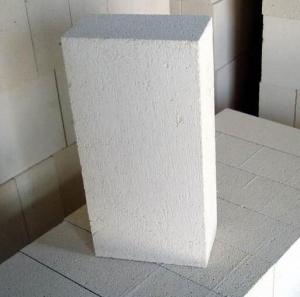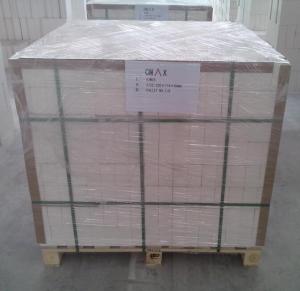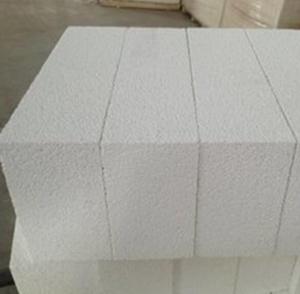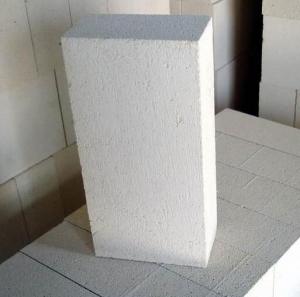Insulation Brick GJM23 26 28 30 For Differnet Application of Steel Industry
- Loading Port:
- Tianjin
- Payment Terms:
- TT or LC
- Min Order Qty:
- 1000 watt
- Supply Capability:
- 1000000 watt/month
OKorder Service Pledge
OKorder Financial Service
You Might Also Like
General Information
CMAX insulating firebricks are classified under temperature between 1100℃ to 1700℃, manufactured from high purity alumina clay.
Features
◆Light weight and low thermal conductivity
◆Low heat storage
◆Low iron and impurities
◆High thermal shock resistance
Application
CMAX insulating firebricks can be used as a hot face lining directly exposed to the heat or as a backup insulation layer in iron and steel mills, non-ferrous foundries, petrochemical, ceramic, glass.
Technical Data
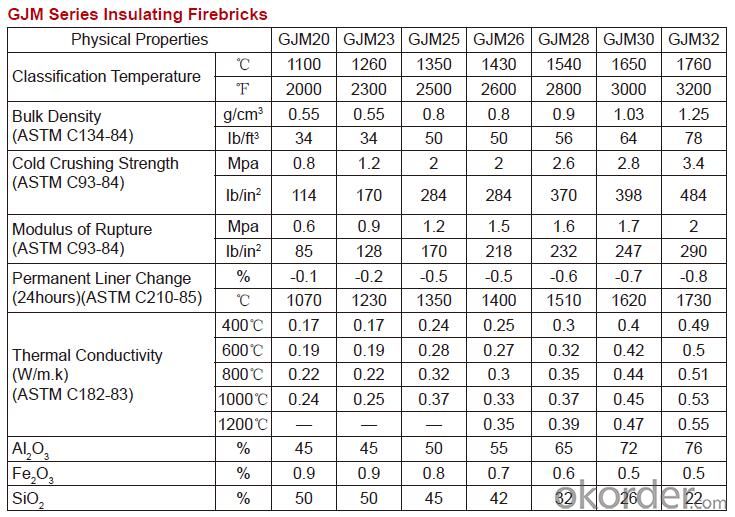
This information, subject to change, is offered solely for your consideration. Users of our products should make their
own tests to determine the suitability of each product for their particular purposes.
Company Information
CNBM International Corp., established in 2004, is the business entity for international business and logistic of CNBM Group.
CNBM International is highly recognized by its business partners and clients all over the world and has established good business relationship with the customers in over 160 countries and regions all over the world.
Production Control
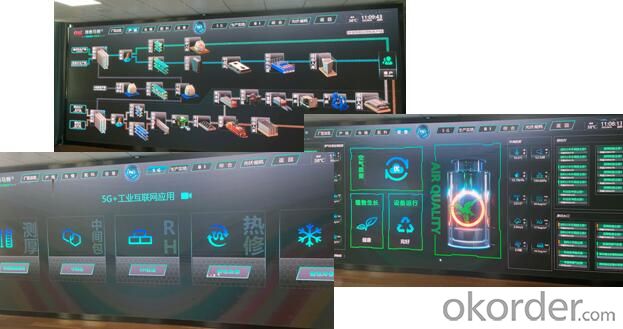
FAQ
Q:Are you a trading company or manufacturer?
A:CNBM is a large-scale central governmental industrial group with its own manufacturing sector, research and development sector, trading sector and logistics sector.
Q:I have some special requirement about specifications.
A:We have a well-rounded product range, which endows us with the capability of applying many special specifications. Please feel free to contact us with yours.
Q:Do you accept OEM service?
A:Yes, we do.
Q:What is your delivery time?
A:It depends on the size/complexity of your order and our own production schedule. Usually we provide a faster delivery than the industry's average.
Q:What is the payment term?
A:Our payment terms are negotiable.
Q:Can I have my own logo on the product?
A:Sure, we can apply your own logo on the products according to your drawings.
- Q:What are insulation bricks for? Do not use high-rise buildings on the ah?
- Heat preservation and heat insulation, that depends on the design of the drawing
- Q:Can insulating fire bricks be used in the construction of pottery molds?
- Insulating fire bricks are indeed applicable for the construction of pottery molds. Crafted from lightweight refractory materials, these bricks possess exceptional heat insulation qualities. Specifically engineered for high-temperature applications like pottery kilns, they offer a range of benefits. When constructing pottery molds, it is imperative to utilize materials that can endure the kiln's intense heat. Insulating fire bricks can withstand temperatures of up to 3000°F (1650°C), rendering them ideal for pottery mold construction. They provide insulation to prevent heat dissipation and maintain consistent temperatures within the kiln, crucial for achieving the desired firing results. Moreover, insulating fire bricks can be conveniently shaped and cut to suit the designated mold design. Their lightweight nature also simplifies handling during the mold construction process. Additionally, the insulating properties of these bricks curtail energy consumption by preventing excessive heat loss, making them a cost-effective choice in the long term. All in all, insulating fire bricks prove to be a fitting option for constructing pottery molds due to their capacity to withstand high temperatures, offer insulation, and be easily molded to meet specific design requirements.
- Q:How do insulating fire bricks help improve the efficiency of heat treatment processes?
- Insulating fire bricks play a crucial role in improving the efficiency of heat treatment processes. These bricks are specially designed to have low thermal conductivity, which means they are excellent at insulating against heat transfer. This insulation property helps to minimize heat loss and maintain high temperatures within the heat treatment furnaces or kilns. By using insulating fire bricks, the heat treatment process can achieve higher temperatures more efficiently. The bricks act as a barrier, preventing the heat from escaping the furnace and ensuring that it remains concentrated inside. This not only enhances the overall energy efficiency of the heat treatment process but also reduces the need for excessive fuel consumption. Furthermore, insulating fire bricks also contribute to a reduction in the heating time required for the heat treatment process. Due to their low thermal conductivity, they minimize the heat loss to the surrounding environment, allowing the furnace to reach the desired temperature quickly. This not only saves time but also reduces the energy consumption associated with prolonged heating. In addition to thermal insulation, insulating fire bricks also provide mechanical strength and durability. They can withstand high temperatures without undergoing significant structural changes or damage. This ensures that the bricks maintain their insulating properties over an extended period, allowing for consistent and efficient heat treatment processes. Moreover, the use of insulating fire bricks helps to create a more controlled and stable thermal environment within the furnace or kiln. Their insulation properties prevent temperature fluctuations and hotspots, ensuring uniform heat distribution throughout the treatment process. This stability is crucial for achieving consistent and high-quality results in heat treatment applications. In conclusion, insulating fire bricks are essential in improving the efficiency of heat treatment processes. Their low thermal conductivity, ability to minimize heat loss, and capacity to withstand high temperatures contribute to reduced energy consumption, faster heating times, and improved temperature control. By incorporating these bricks, heat treatment operations can achieve higher efficiency, lower costs, and more consistent results.
- Q:What is the typical thermal diffusivity of an insulating fire brick?
- The typical thermal diffusivity of an insulating fire brick can vary depending on the specific composition and manufacturing process of the brick. However, as a general guideline, insulating fire bricks typically have thermal diffusivity values ranging from around 0.05 to 0.2 mm²/s. Thermal diffusivity is a measure of how quickly heat can be conducted through a material. A low thermal diffusivity indicates that the material is a good insulator, as it does not conduct heat rapidly. Insulating fire bricks are designed to have low thermal diffusivity in order to minimize heat transfer and provide effective insulation in high-temperature applications, such as in furnaces, kilns, and fireplaces. It is worth noting that the specific thermal diffusivity of an insulating fire brick can be influenced by factors such as the type of raw materials used, the manufacturing process (including the firing temperature and duration), and any additives or coatings applied to enhance insulation properties. Therefore, it is important to consult the manufacturer's specifications or conduct specific tests to determine the thermal diffusivity of a particular insulating fire brick.
- Q:Can insulating fire bricks be used for insulation in gas furnaces?
- Indeed, insulation in gas furnaces can be achieved by utilizing insulating fire bricks. These bricks are crafted from lightweight materials like clay and other minerals, boasting remarkable insulation capabilities. Specifically engineered to endure extreme temperatures, they are extensively employed in industrial settings, notably gas furnaces. By reducing heat loss, enhancing energy efficiency, and sustaining elevated temperatures within the furnace, these bricks play a crucial role. Furthermore, they exhibit resistance to thermal shock and can withstand the corrosive impact of gases and chemicals commonly found in gas furnaces. Hence, insulating fire bricks serve as a suitable option for insulating gas furnaces.
- Q:Can insulating fire bricks be used in the construction of boilers for steam generation?
- Indeed, insulating fire bricks possess the capability to be employed in the manufacturing process of steam-generating boilers. These bricks are purposefully engineered to possess a meager thermal conductivity, thereby mitigating heat dissipation and enhancing the boiler's overall energy efficiency. In practice, they are frequently utilized in the construction of boiler partitions, bases, and furnace linings, given their ability to endure extreme temperatures and bestow remarkable insulation attributes. The integration of insulating fire bricks in boiler construction ensures that the heat generated from fuel combustion is efficiently contained and transferred to the water, culminating in proficient steam generation.
- Q:What is a JQK composite lightweight thermal insulation brick?
- Its characteristic is waterproof and heat insulation, thermal insulation performance, strong decoration, waterproof effect is good, and good weathering resistance, long service life, the whole system of simple construction, low cost, is a new type of inverted waterproof and insulation structure of the current system state key application.
- Q:Do insulating fire bricks require a specific curing or drying process before use?
- Yes, insulating fire bricks typically require a specific curing or drying process before use. This is done to remove any moisture or volatile organic compounds (VOCs) that may be present in the bricks, as well as to ensure they achieve their maximum insulating properties. The curing or drying process for insulating fire bricks usually involves slowly heating the bricks to gradually increase their temperature. This allows any moisture or VOCs to be released without causing any cracks or damage to the bricks. The rate of temperature increase and the overall duration of the curing process can vary depending on the type and thickness of the bricks. It is important to follow the manufacturer's instructions and recommendations for the specific type of insulating fire bricks being used. This will ensure that the curing or drying process is carried out correctly and that the bricks are ready for use in high-temperature applications such as kilns, furnaces, or fireplaces. Neglecting to properly cure or dry the bricks may result in reduced insulating properties and potential cracking or failure of the bricks when exposed to high temperatures.
- Q:Can insulating fire bricks be used for insulation in chemical storage tanks?
- Indeed, insulation in chemical storage tanks can be achieved by utilizing insulating fire bricks. These bricks, purposefully engineered to offer exceptional thermal insulation, lend themselves well to a wide range of industrial uses, including chemical storage tanks. Their outstanding insulating properties stem from their low thermal conductivity, ensuring minimal heat transfer and a consistent internal temperature within the tank. Moreover, these fire bricks exhibit remarkable resistance to high temperatures and the corrosive effects of various chemicals, rendering them a fitting option for insulation in chemical storage tanks.
- Q:Can insulating fire bricks be used in the construction of steam generators?
- Yes, insulating fire bricks can be used in the construction of steam generators. These bricks are designed to withstand high temperatures and provide insulation, making them suitable for applications such as steam generators where heat retention is important.
1. Manufacturer Overview |
|
|---|---|
| Location | |
| Year Established | |
| Annual Output Value | |
| Main Markets | |
| Company Certifications | |
2. Manufacturer Certificates |
|
|---|---|
| a) Certification Name | |
| Range | |
| Reference | |
| Validity Period | |
3. Manufacturer Capability |
|
|---|---|
| a)Trade Capacity | |
| Nearest Port | |
| Export Percentage | |
| No.of Employees in Trade Department | |
| Language Spoken: | |
| b)Factory Information | |
| Factory Size: | |
| No. of Production Lines | |
| Contract Manufacturing | |
| Product Price Range | |
Send your message to us
Insulation Brick GJM23 26 28 30 For Differnet Application of Steel Industry
- Loading Port:
- Tianjin
- Payment Terms:
- TT or LC
- Min Order Qty:
- 1000 watt
- Supply Capability:
- 1000000 watt/month
OKorder Service Pledge
OKorder Financial Service
Similar products
New products
Hot products
Related keywords
